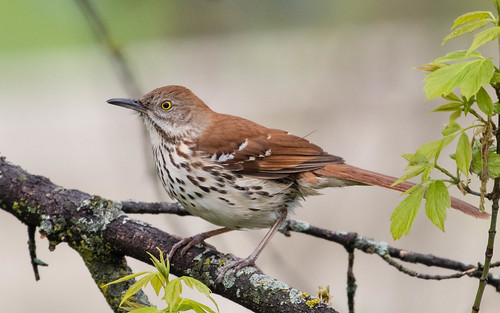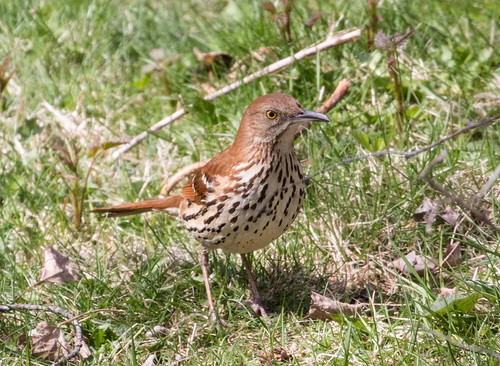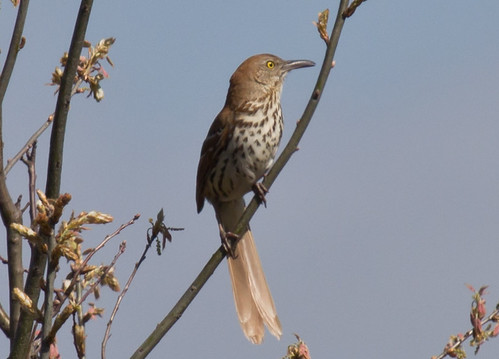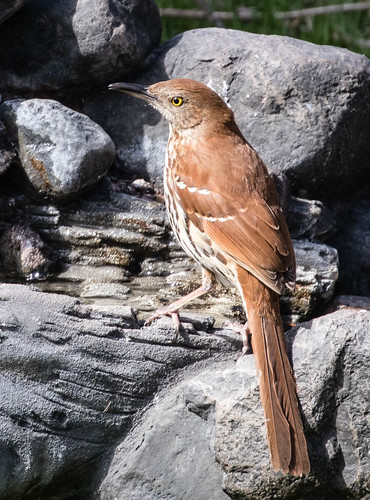On May 9, 1975, I saw two beautiful birds on the Michigan State campus, new for my lifelist, a pair of Brown Thrashers. The rich rusty color, long tail, bright yellow eyes, and streaking on the creamy underside were unique and memorable. I’d never imagined such a bird before, and now would never forget it.
I didn’t write in my notes what called my attention to them, but I do know the male was not singing, at least not the full-throated song I learned the following year, or I’d have reported that in my notes. As I learned more about the species, I realized that of course he wasn’t singing—once a thrasher attracts a mate, he pretty much shuts up for the season. He may have been singing his soft whisper song, which males occasionally do near their mates, but I was hardly a savvy observer. There were too many sounds out there that I wasn’t paying attention to yet—so much muddled background noise and scenery bombarding my senses, and it took time for my eyes and ears to make sense of it all.
The next month, I took ornithology and another class at the Kellogg Biological Station in Kalamazoo, Michigan, and spent every other waking moment looking for birds. On Saturday, June 21, I noticed a Brown Thrasher hop into a shrub as I was driving out the exit of a Lansing nature center, and then on Monday, June 23, I saw a couple on an ornithology field trip. One walked along a fence row and then flew to a mulberry tree. When a robin chased it off, another thrasher flew to the tree and chased the robin off. Our instructor said they sing their song phrases in pairs, but we didn’t hear one. A couple of weeks later, one evening I saw three on the ground in an open area near dense shrubs on the Michigan State campus.
That was it for my encounters with Brown Thrashers that first year of birding. The next year I saw them much more often, adding them to my Ontario, Illinois, South Carolina, Georgia, and Wisconsin lists. As I grew more experienced, I got better and better at noticing them, skulking in and near dense shrubs or singing, sometimes wonderfully out in the open on a high bare branch.
That spring of 1976, I took my second ornithology class. For our field exam, the professor pointed to a bird in the open or in the general direction of a vocalization, and we’d have to identify it. The moment he pointed toward a singing Brown Thrasher, the bird flew to a more distant perch and kept singing. I’d already noticed him, so I wrote down the answer, but none of the other students had been on the bird when it was first pointed out, and it was hard to hear from the distant perch. The rule was if the bird flew before any of the students got on it, the prof tossed out the question, but he could see I got it in time. He tried to help the others by giving hints—“Listen! He’s singing everything twice: 'Get the seed! Get the seed! Drop it! Drop it! Cover it up! Cover it up! Water it! Water it!'” but no one else got it, even with his pretty clear hint. I was always pleased to get an A in a class, but I was never prouder than I was getting the only 100 percent on that field exam. So that Brown Thrasher became my Best Bird EVER! But the very next year, he was toppled from the position by a Brown Thrasher that I never even saw.
We moved to Madison, Wisconsin, the month after that ornithology class ended. Our first year there, before I got my teaching job, I worked as a bank teller. I was an excellent teller in terms of being accurate with money and nice to customers, but my heart wasn't really in it. One April day in 1977, an executive of a big company got into my line while I was in the middle of a long, complicated transaction. As other tellers finished with their own customers, the head teller, a stern woman who did not approve of me, kept inviting him to go to someone else's open window, but he politely declined, saying he needed to talk to me. She gave me a questioning frown, but I had no idea what he wanted either, and assumed the same thing she did, that he was going to reprimand me for some egregious mistake I must have made.
But no! When I finally finished with my long transaction, he stepped up with a simple deposit and a simpler question. He’d seen the coolest bird in his backyard that morning—a gorgeous rusty brown bird with a long tail and golden eyes. Before he was even finished describing it, I’d pulled out my trusty Golden Guide and opened it to the picture of the Brown Thrasher.
He was utterly delighted. As he passed the vice president’s desk, he told him he should give me a raise for such high-quality customer service. The vice president beamed at me. The head teller pursed her lips and walked away.
How could I not love Brown Thrashers even more after that? Birds enhance our lives in so many ways, bringing color and vivacity and song to even the most ordinary days. And once in a while, if we’re very lucky, a bird can even get us bonus points at work. Even though I never even saw it, that Brown Thrasher in that customer’s backyard way back in 1977 was my best bird EVER!





